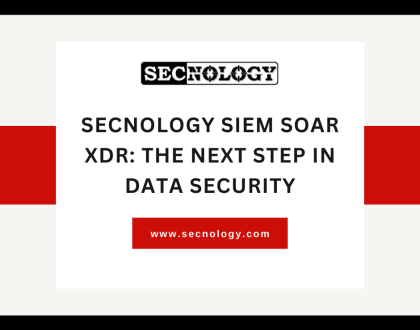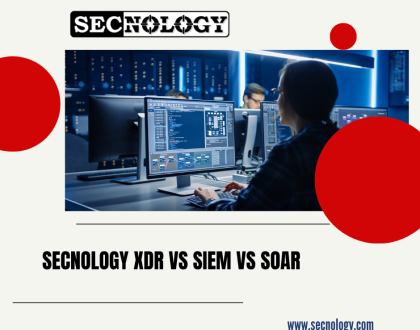SECNOLOGY : Overcome cyber threats with security automation

Learn how organizations are embracing security orchestration strategies and tools, including security orchestration automation and response (SOAR).
Preventing and mitigating cyberattacks is becoming increasingly difficult as their number and sophistication continue to grow. Security experts often have no method to effectively oversee the thousands of alerts generated by heterogeneous security tools. To mitigate these possible threats, analysts must also perform repetitive manual tasks. Beyond the lack of time and personnel, many organizations simply can’t keep up with the volume of security work that curbs their incident response capacities.
So to optimize their threat management operations, companies are acquiring SOAR solutions.
In this blog, we present a definition of security automation and orchestration, a description of its applications, and an explanation of the role of machine learning in the development of SOAR tools.
Let’s define security automation?
Security automation is the process of automating the execution of security operations tasks, such as vulnerability scanning, without manual intervention. Tools such as security monitoring, intrusion detection systems and SIEMs use automation for threat detection.
As attacks on organizations, such as phishing campaigns, become more frequent and advanced, technology has infiltrated every day activity, producing an continually increasing volume of data. Security experts, using security software and tools, filter data alerts to expose unseen threats.
Organizations have to confront a multitude of functional challenges. The merger of : recruiting and deploying and developing security flair, high volumes of alerts and incidents to assess, and the constant switching among security tools as a segment of the investigation and response tasks, known as the “revolving chair” response, typically results in what seems a constant backlog.
Security automation solutions answer these problems by automatically driving security tasks that would elseways have to be accomplished manually by the security experts.
Automation of time-consuming and repetitive tasks:
– Decrease response time
– Minimize human error
– Decrease alert fatigue
SOAR , what is it?
SOAR is Security orchestration, automation and response. An arranged group of software, or assembled solution, that permits an organization to aggregate threat data from several streams and automatically respond to low-grade security events without manual intervention.
Those technical solutions aid in defining, prioritize, standardizing and automating incident response priorities. SOAR services succesfully orchestrate inside and outside applications. This increases the functionality of the onsite SIEM software. The main attributes of the SOAR solution are as follows:
– Security Orchestration: Offers an overview of the organization’s security posture by consolidating other security solutions. Correlates internal data with outside threat data sources, empowering security experts to discover and mitigate threats at the point of origin.
– Security automation: Manages security tasks like query logs, IP reputation, and allowing or denying permissions. By leveraging the built-in functionality of the security orchestration tool, there is no need to use multiple security tools for the same task.
How SOAR supports the SOC
SOC is a service that manages internal enterprise security issues. SOAR solutions allow security experts to concentrate on high-priority events by automating time-consuming tasks such as gathering threat intelligence, enhancing indicators of compromise (IOCs) for context, and mitigating low-level threats.
SIEM vs SOAR
Organizations usually work the two solutions in conjunction because they complete each other. The Security Information and Event Management (SIEM) solution aggregates log data from multiple sources by supplying real-time alerts, and SOAR builds and integrates a more extensive list of tools on this basis.
SIEM offers rules of correlation and in some instances behavior analysis to find anomalies and generate alerts. Yet, legacy SIEM solutions often generate excessive alerts for the security team to handle manually. Here is why the SOAR excels. It can supplement SIEM by automating the IR workflow, automatically managing low-level threats and cutting time for the security experts.
Companies opt to add SOAR to their security toolbox essentially because it lets security teams focus on high-priority events by automating routine, time-consuming duties. This solution aids experts provide background information for incidents by showing processed data from various sources such as threat intelligence frameworks with the SECNOLOGY security management platform
SECNOLOGY is a SIEM and SOAR platform that combines security Big Data mining with machine learning and security analytics to effectively respond to threats.
Key features include:
SECNOLOGY machine-created timelines of user and device behavior that reduce the time and specialization required to detect and investigate attacker tactics, techniques and procedures.
Automate and orchestrate incident response. Organizations can respond to security events quickly and effortlessly through pre-built integrations with dozens of security tools such as endpoint detection and response, firewalls, and more.
Consolidate all data into a central repository so you can easily scale security operations.
Identify suspicious behavior with user and entity behavior analysis (UEBA).
Unlimited data collection.
Organizations can quickly benefit from deploying a complete end-to-end SIEM solution with SOAR, leveraging automation and integration of security tasks and tools to improve their threat intelligence and stay ahead of attackers.
For more information on SECNOLOGY please visit this link : www.secnology.com
Or directly contact us using the contact form.




